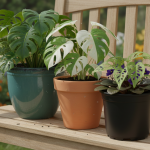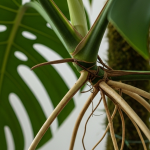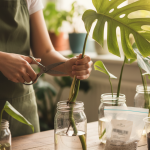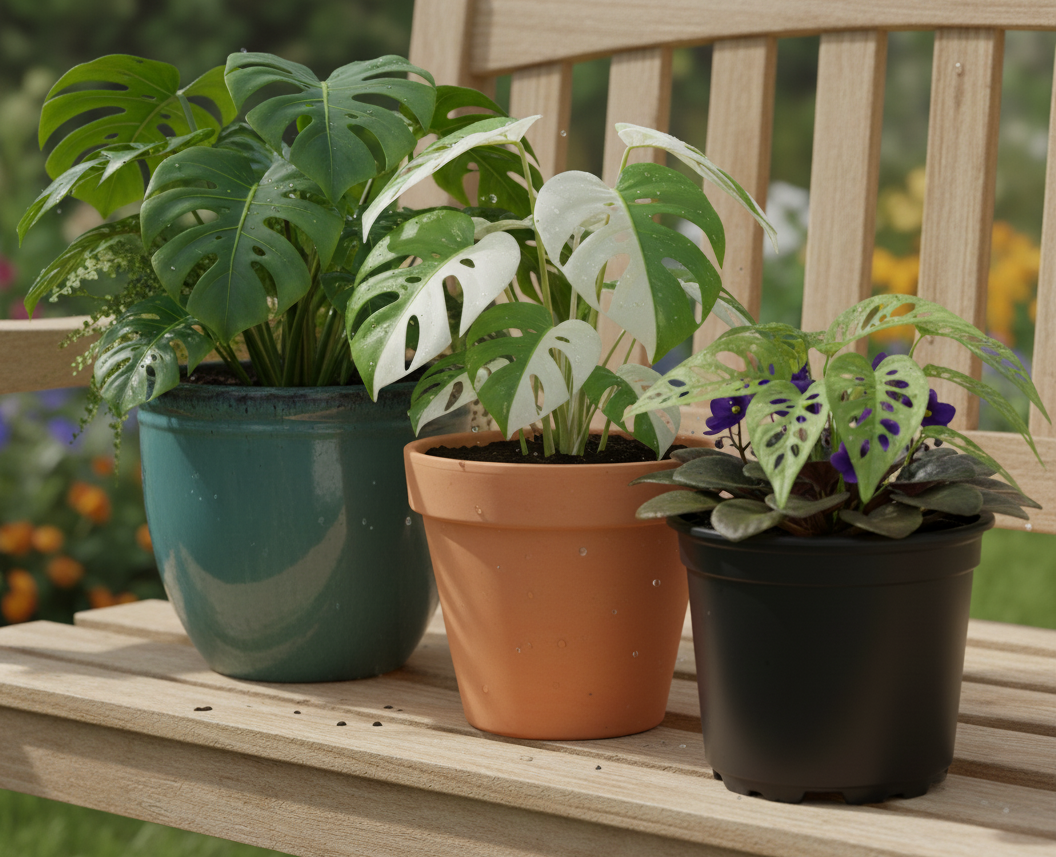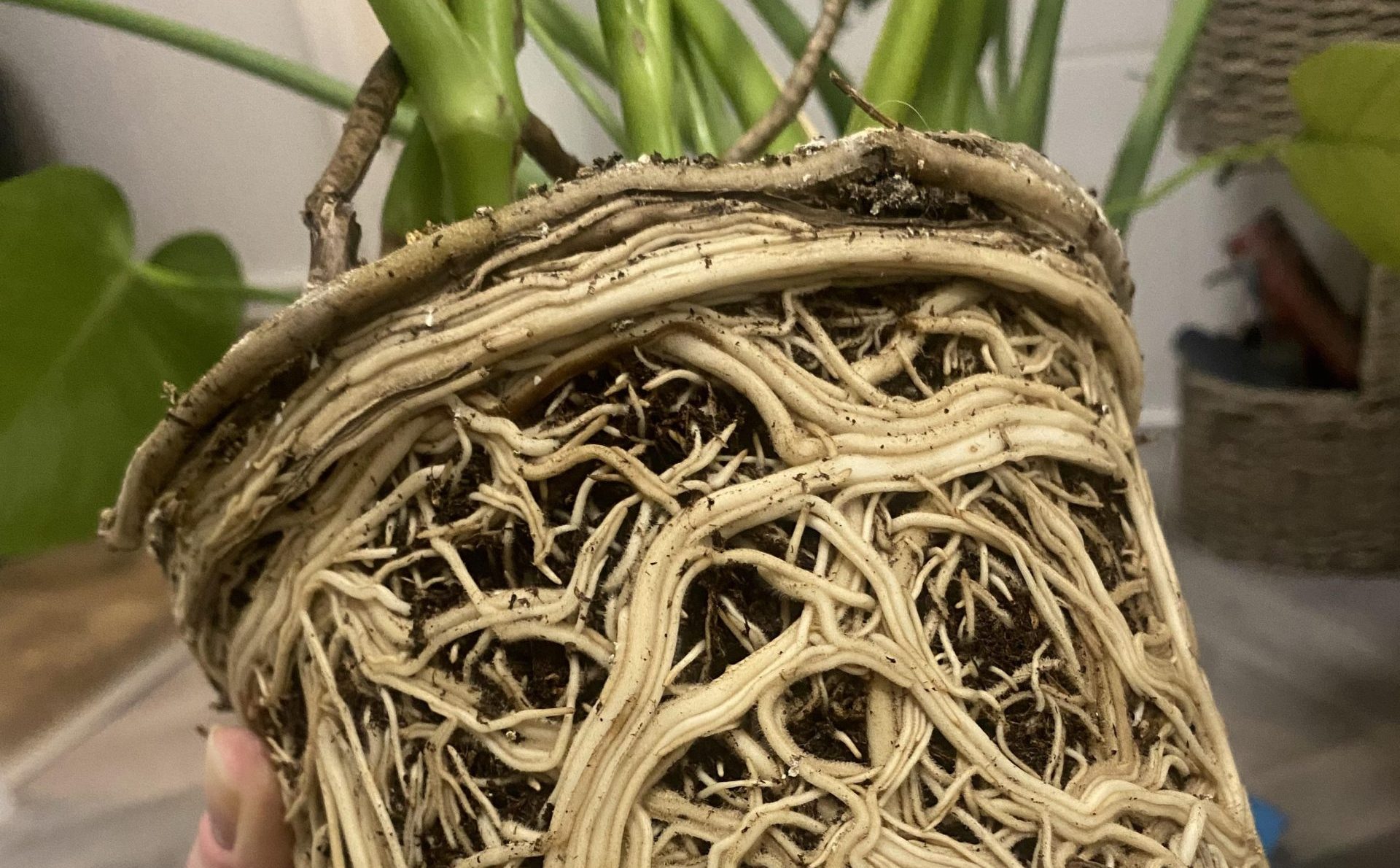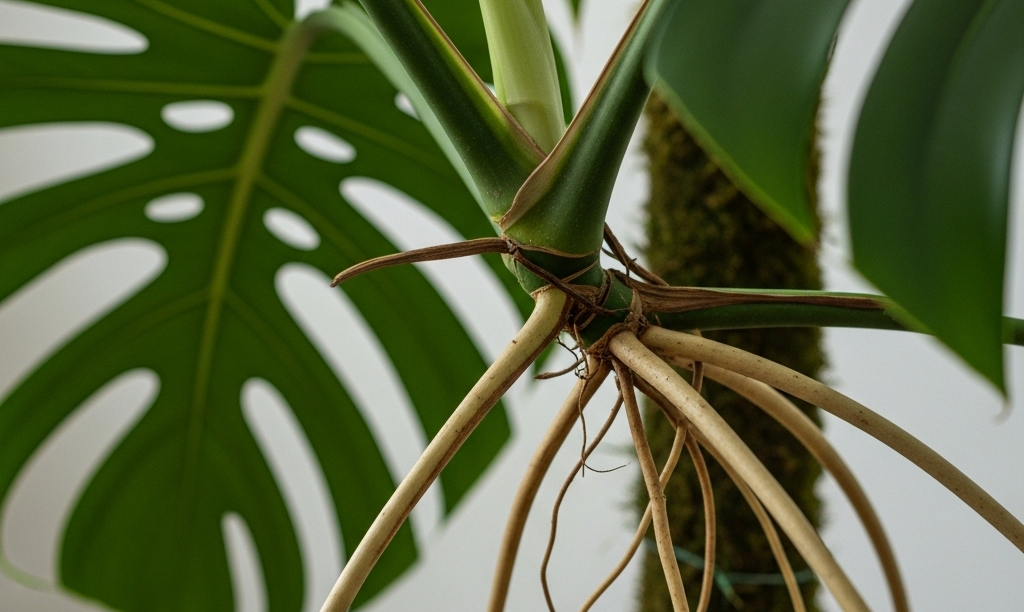If you’ve dipped your toes into the world of indoor plants, you’ve probably noticed that some plants are… well, just plants, and others are plant royalty. Sitting right at the top of the throne is the variegated Monstera deliciosa – a true showstopper with those marbled, split leaves that can make any living room look like it belongs in a design magazine.
The problem? These beauties are rare as hen’s teeth and often cost more than your monthly grocery bill. In South Africa, small cuttings have sold for over R15,000, while in Australia you’ll fork out close to a grand in AUD for a half-decent size plant. That’s not a typo. People are paying serious money for a bit of white-and-green leaf.
So, if you’re lucky (or crazy) enough to own one, you want to make sure you look after it properly. The good news is: with the right care, your variegated Monstera will thrive, reward you with stunning new leaves, and could even become an investment plant you can propagate and share (or sell for extra cash).
This guide covers everything you need to know – from light, soil, and watering, to propagation, pruning, and even a few tricks to keep the variegation looking sharp. Let’s dig in.
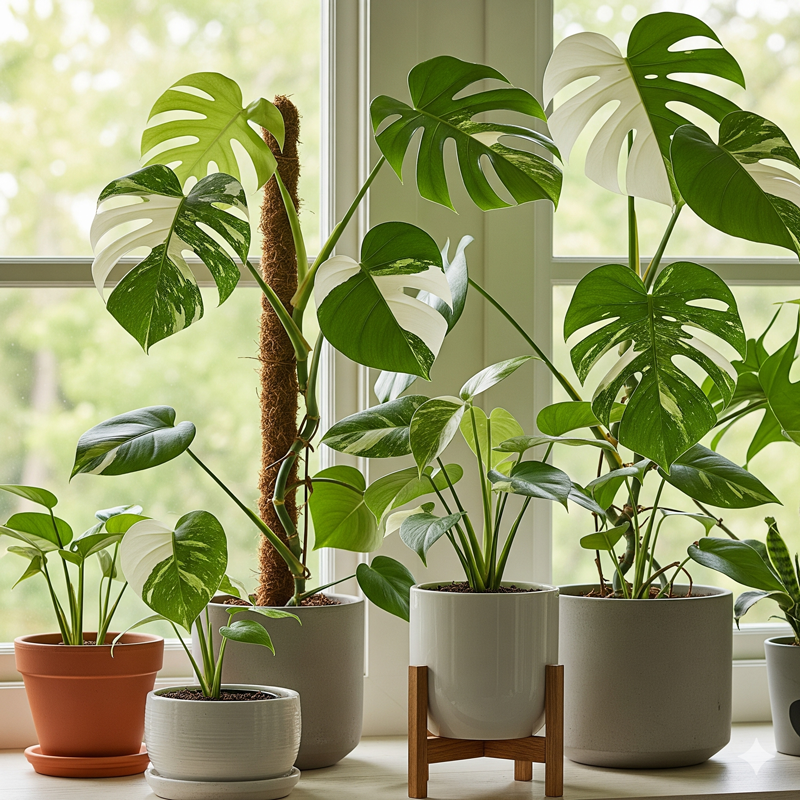
What Makes a Variegated Monstera Special?
Before we jump into the “how,” let’s quickly talk about the “what.” A regular Monstera deliciosa is already an iconic plant, famous for its big, fenestrated (split) leaves. But the variegated version has streaks, marbling, or chunks of creamy white mixed into the green.
This variegation isn’t just for show – it’s actually a genetic mutation. Because the white parts lack chlorophyll (the stuff that allows plants to photosynthesise), they can’t make food for the plant. That’s why variegated Monsteras grow more slowly and need a little more care than their solid green cousins.
There are a few different types of variegated Monsteras:
- Monstera deliciosa ‘Albo Variegata’ – White variegation, usually in splashes, streaks, or big patches.
- Monstera deliciosa ‘Thai Constellation’ – Creamy-yellow speckles and marbling, stable variegation that’s tissue-cultured.
- Half-Moon – Leaves split down the middle, one side green, the other pure white. Extremely rare.
Each type has its own vibe, but the care tips below apply to all of them.
1. Light: The Most Important Factor
If there’s one thing to get right, it’s lighting. Because variegated Monsteras have less green tissue, they can’t photosynthesise as efficiently as regular Monsteras. That means they need brighter light to stay healthy.
- Place your plant near the brightest window in your house.
- Aim for bright, indirect light – think a north-facing window in South Africa, or east-facing in Australia.
- Morning sun is fine, but harsh midday sun will scorch the white parts of the leaves.
If your home doesn’t get enough natural light, invest in a grow light. In winter or gloomy flats, it can be the difference between a thriving Monstera and a sad, leggy one.
⚠️ Watch out for fading variegation. If your new leaves come in mostly green, your plant might not be getting enough light. Move it closer to the window or add artificial light.
2. Watering: Don’t Kill It with Kindness
Monsteras don’t like soggy feet. Overwatering is one of the quickest ways to kill your plant, and given what you paid for it, that’s an expensive mistake.
Here’s how to water properly:
- Stick your finger into the soil – if the top quarter to a third is dry, it’s time to water.
- Water thoroughly until liquid drains from the bottom of the pot.
- Empty the saucer after 10–15 minutes so roots don’t sit in water.
- In summer, you might water weekly. In winter, every 2–3 weeks is enough.
⚠️ Red flag: Yellowing leaves with black, mushy stems = root rot. Immediately pull the plant from the pot, trim the rotted roots, and repot in fresh soil.
3. Soil: Keep It Chunky and Free-Draining
Variegated Monsteras are aroids, which means they naturally grow in rainforest conditions where their roots can climb trees and get lots of airflow. To mimic that, you want soil that’s chunky, airy, and drains well.
The perfect mix is:
- 40% quality potting soil
- 30% orchid bark (or pine bark chips)
- 20% perlite
- 10% coco coir or sphagnum moss
This mix keeps moisture but also gives plenty of oxygen to the roots. If your soil feels heavy and compact, your Monstera will sulk.
4. Feeding: Fuel for Growth
Because they grow slower, variegated Monsteras don’t need loads of fertiliser – but they do need a steady supply during spring and summer.
- Use a balanced liquid fertiliser (something like 20-20-20).
- Dilute it to half-strength.
- Feed every 2–3 weeks.
Every couple of months, give the soil a good flush with plain water to wash away any salt build-up. If you notice brown, crispy edges, it might be fertiliser burn – cut back immediately.
5. Repotting and Moss Poles
Monsteras are natural climbers, so if you want those big, fenestrated leaves, you’ll need to give yours something to climb. A moss pole, bamboo stake, or even a DIY trellis works.
- Repot every 1–2 years when the roots start circling the pot.
- Always size up gradually – going from a 15cm pot to a 30cm pot is too much, and your soil will stay too wet.
- Use a heavy pot (terracotta or ceramic) so it doesn’t topple over.
Pro tip: when you repot, gently loosen the root ball and tuck the aerial roots into the moss pole. This helps the plant anchor and climb faster.
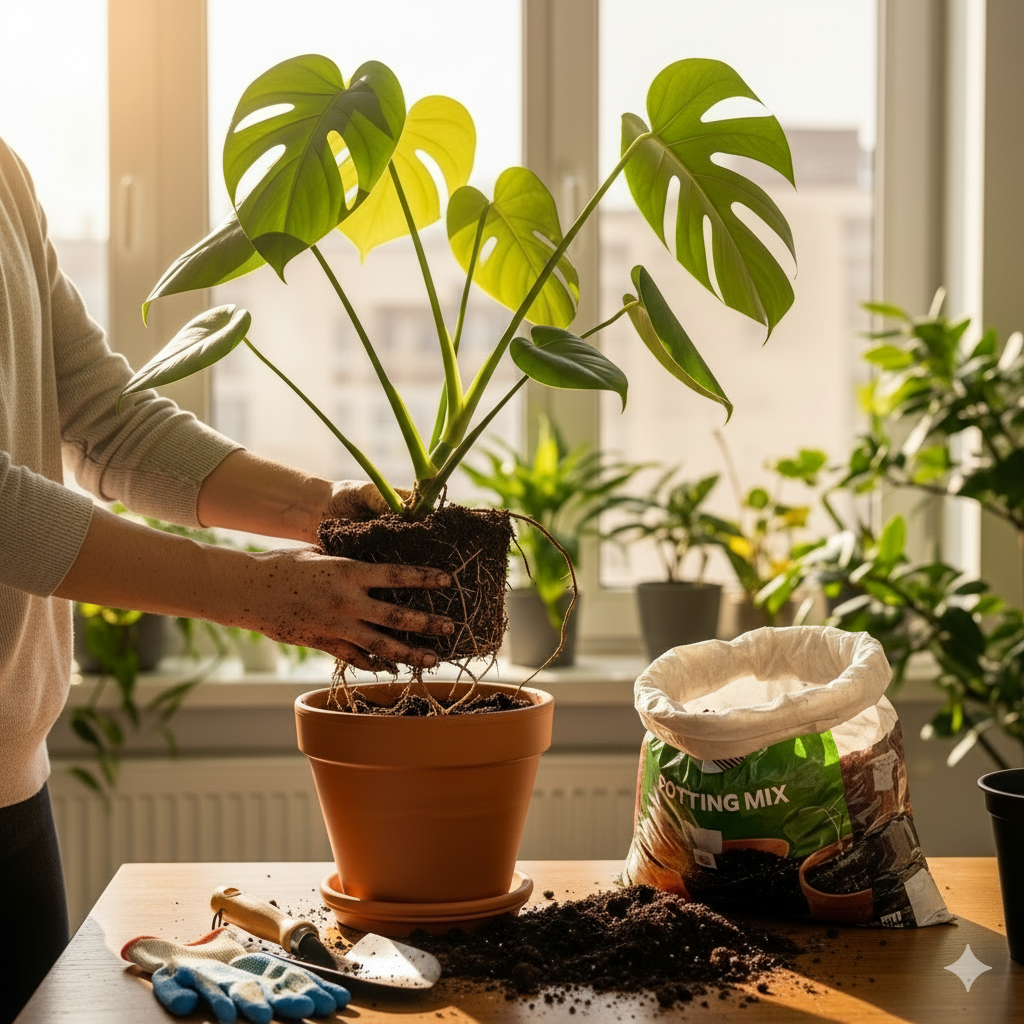
6. Pruning and Managing Variegation
This is where things get interesting. Because variegation is unstable, your plant might push out leaves that are all white or all green. Neither is ideal.
- All white leaves look amazing but will die off quickly – no chlorophyll = no energy.
- All green leaves mean your plant could lose its variegation over time.
The trick is to prune strategically. Cut back to a node with balanced variegation, and your new growth will usually even out. Don’t be afraid to trim – you’re guiding your plant, not harming it.
7. Propagation: Share the Love (or Make Some Money)
One of the best things about owning a variegated Monstera is that you can propagate it. With the prices they fetch, a healthy cutting can practically pay for your next holiday.
How to propagate:
- Choose a stem with at least one node and ideally an aerial root.
- Cut cleanly below the node.
- Place in water or straight into chunky soil.
- Keep warm and humid until roots develop.
Water propagation is fun because you can watch the roots grow, but soil propagation usually produces stronger plants.
8. Common Problems and Fixes
- Brown edges: Usually low humidity or too much fertiliser.
- Yellow leaves: Overwatering or lack of nutrients.
- Drooping: Thirsty or rootbound.
- Pests: Mealybugs and spider mites love Monsteras. Wipe leaves regularly and treat with neem oil if needed.
9. Pets and Kids – A Quick Warning
As gorgeous as they are, Monsteras are toxic to cats, dogs, and kids if chewed. They contain calcium oxalate crystals that can cause mouth irritation, drooling, and stomach upset. Keep yours out of reach if you’ve got curious pets or toddlers.
10. Why They’re Worth the Effort
Yes, they’re pricey. Yes, they’re a bit fussy compared to a pothos or snake plant. But the joy of seeing a fresh variegated leaf unfurl never gets old. Each new leaf is different – like your plant is painting its own artwork.
And if you ever decide to propagate and sell, you might just make back every cent you spent (and then some).
Owning a variegated Monstera feels a bit like joining an exclusive club. They’re rare, they’re sought-after, and when you get it right, they’re absolutely spectacular.
Final Word
Whether you’re in Durban, Sydney, or anywhere in between, the golden rules are the same:
- Give it bright, indirect light.
- Keep the soil chunky and airy.
- Water deeply, but not too often.
- Support it with a moss pole.
- Prune smartly to keep that variegation balanced.
Do that, and your Monstera won’t just survive – it’ll thrive. And who knows? A few years from now, you could be the one selling cuttings for a small fortune.
Until then, enjoy every new leaf. After all, this isn’t just another houseplant. This is the plant.
